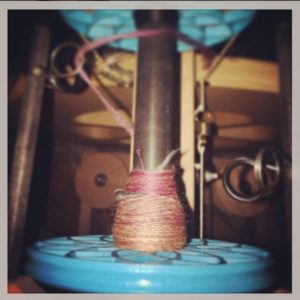
To those who aren’t fiber crafters or know someone who is, the idea of spinning yarn is antiquated – if it’s even thought of as something that happens. Hard as it believes, yarn doesn’t fall off the sheep and find itself in brightly colored string-form. Fiber arts – as a catchall – are really one part craftsmanship and one part true art. The craft portion finds itself in high-quality workmanship. The lengthy process that occurs in the creation of yarn, the weaving of a scarf or even just the reading of a complex cable knitting pattern. These are trained-skills that provide an immense value of satisfaction. The artistic part comes after the skill and is all in the execution. Twenty people can make the same hat. But there are several dozen individualized choices along the way that can change your hat from every other hat in seconds. The art is a decision of the maker.
I’ve always been someone who habitually is good at things. Far from being a not-so-humble brag, that has always been my downfall. See, I tend to be good at things quickly. Playing clarinet, for example, came so easily to me that it was a piece of cake to learn numerous other instruments. I sight-read my audition to Julliard, playing it for the first time well enough to earn the acceptance of a highly-coveted admissions seat. The first time I went skiing – after I worked to get past the fear-factor of plummeting into a tree – was an exercise of amazement. I just “knew” what to do and it came naturally. As a result of being naturally good at so many things I enjoy, I avoid things I am not immediately good at. In fact, I assume it’s a problem with the thing I am trying and never me. I am unable to draw much more than a stick figure because I was never willing to practice. The first half dozen times I picked up knitting needles, I failed so epically that I stuck to crochet with a tightly clenched hook in hand.
Spinning yarn was another craft I did not exceed at immediately. The drop spindle earned it’s namesake and I threw it into the back of the closet with no plans to find it again. A few years later, I was at Gauge & Tension for the NYC Yarn Crawl when I spotted a beautiful fiber. I decided to buy it and give the spinning “thing” another attempt. Immediately, it was good at it. My first draft of the fiber onto my spindle produced a thin, even yarn with the ideal twist.
I’ve delved much farther into spinning yarn since then – moving from drop spindle to wheel to another wheel to a giant fiber stash – but one skill that both spinning, craftsmanship and life all share still eludes me: patience. It probably surprises no one that another fault that comes from having a natural propensity toward certain skills is that I’ve never been patient enough to sit down and practice at something I might be bad at. That said, in the never-ending goal of improving myself, I am trying to teach myself patience.
While I may be skilled at spinning, I am by no means an expert and there are still several knowledge gaps I possess and openly admit to. One of them is that I’ve never spun a full 4 oz braid. Instead, I always give up at some point and waste the rest of the braid. I’ve also never spun a yarn thin enough for a 3-ply sock yarn. I’ve started trying to do that but have abandoned along the way. My attempts at practicing patience were to finally conquer both of those knowledge gaps.
A big part of the reason I’ve never spun that fine before is that the yarn breaks, frequently. This is actually something that can happen quite commonly when spinning yarn – and lacking the skillset to compensate properly. By the fifth time I have to rethread my yarn through the orifice, I get frustrated and give up. Patience, Yoda.
Another reason I’ve never spun that thin is quite existential. When you draft fiber thin – and I mean THIN – you are trying to add twist to air with a few hair in it before it evaporates. The fiber is pulled past it’s breaking point and there is far more air than there is fiber. It’s just there, sparse and unlikely to be much more than rubbish. My hands instinctively do anything possible to avoid this. I’ll pinch the yarn up higher, I will draft more fiber into the space between my hands, I will do anything. For me, it’s more than fiber arts or craft: it’s one of my most basic fears in life: the unknown.
I am that person who will look up the movie they’re watching on Wikipedia to find out the ending. I am that person who adds minute-marking notation to my written thoughts at work so I can better predict the next question. I am that person who loves watching sports 10-times more when I know the final score. I do not do well in the unknown or uncomfortable. Spinning in this breaking point is, literally, an exercise in the unknown. And I do not like it.
So I am trying to train my brain into being patient and my hands into more deliberate action. I do not know if I expect myself to succeed. I might fail. I think that’s all part of the excercise, isn’t it? To patience – it takes too long!